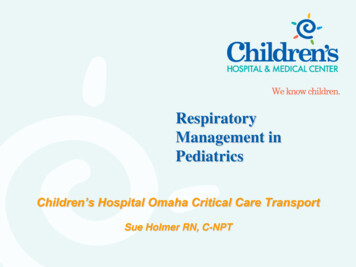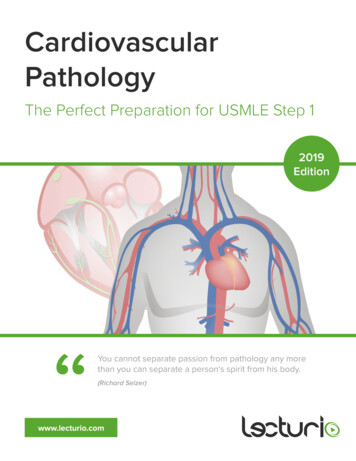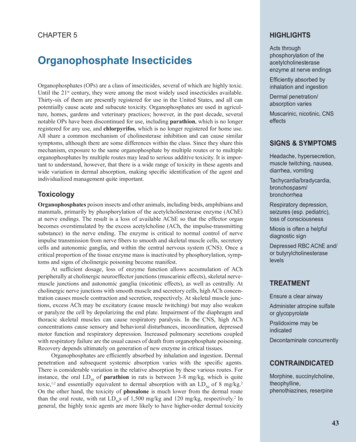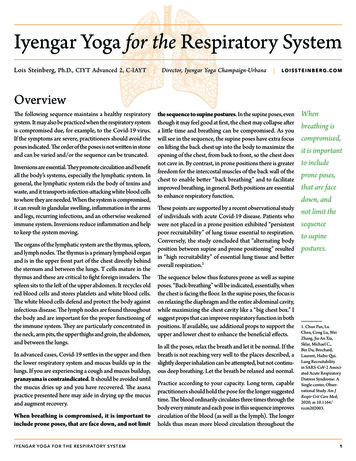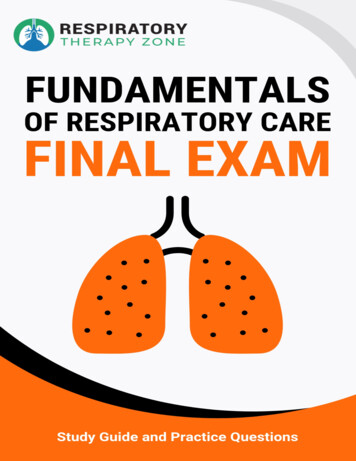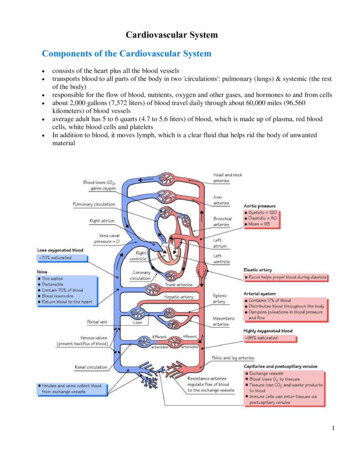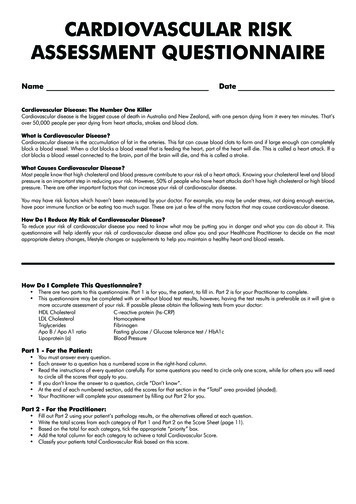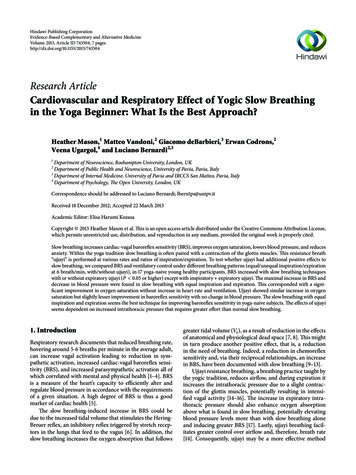
Transcription
Hindawi Publishing CorporationEvidence-Based Complementary and Alternative MedicineVolume 2013, Article ID 743504, 7 pageshttp://dx.doi.org/10.1155/2013/743504Research ArticleCardiovascular and Respiratory Effect of Yogic Slow Breathingin the Yoga Beginner: What Is the Best Approach?Heather Mason,1 Matteo Vandoni,2 Giacomo deBarbieri,3 Erwan Codrons,2Veena Ugargol,4 and Luciano Bernardi2,31Department of Neuroscience, Roehampton University, London, UKDepartment of Public Health and Neuroscience, University of Pavia, Pavia, Italy3Department of Internal Medicine, University of Pavia and IRCCS San Matteo, Pavia, Italy4Department of Psychology, The Open University, London, UK2Correspondence should be addressed to Luciano Bernardi; lbern1ps@unipv.itReceived 18 December 2012; Accepted 22 March 2013Academic Editor: Elisa Harumi KozasaCopyright 2013 Heather Mason et al. This is an open access article distributed under the Creative Commons Attribution License,which permits unrestricted use, distribution, and reproduction in any medium, provided the original work is properly cited.Slow breathing increases cardiac-vagal baroreflex sensitivity (BRS), improves oxygen saturation, lowers blood pressure, and reducesanxiety. Within the yoga tradition slow breathing is often paired with a contraction of the glottis muscles. This resistance breath“ujjayi” is performed at various rates and ratios of inspiration/expiration. To test whether ujjayi had additional positive effects toslow breathing, we compared BRS and ventilatory control under different breathing patterns (equal/unequal inspiration/expirationat 6 breath/min, with/without ujjayi), in 17 yoga-naive young healthy participants. BRS increased with slow breathing techniqueswith or without expiratory ujjayi (𝑃 0.05 or higher) except with inspiratory expiratory ujjayi. The maximal increase in BRS anddecrease in blood pressure were found in slow breathing with equal inspiration and expiration. This corresponded with a significant improvement in oxygen saturation without increase in heart rate and ventilation. Ujjayi showed similar increase in oxygensaturation but slightly lesser improvement in baroreflex sensitivity with no change in blood pressure. The slow breathing with equalinspiration and expiration seems the best technique for improving baroreflex sensitivity in yoga-naive subjects. The effects of ujjayiseems dependent on increased intrathoracic pressure that requires greater effort than normal slow breathing.1. IntroductionRespiratory research documents that reduced breathing rate,hovering around 5-6 breaths per minute in the average adult,can increase vagal activation leading to reduction in sympathetic activation, increased cardiac-vagal baroreflex sensitivity (BRS), and increased parasympathetic activation all ofwhich correlated with mental and physical health [1–4]. BRSis a measure of the heart’s capacity to efficiently alter andregulate blood pressure in accordance with the requirementsof a given situation. A high degree of BRS is thus a goodmarker of cardiac health [5].The slow breathing-induced increase in BRS could bedue to the increased tidal volume that stimulates the HeringBreuer reflex, an inhibitory reflex triggered by stretch receptors in the lungs that feed to the vagus [6]. In addition, theslow breathing increases the oxygen absorption that followsgreater tidal volume (𝑉𝑡 ), as a result of reduction in the effectsof anatomical and physiological dead space [7, 8]. This mightin turn produce another positive effect, that is, a reductionin the need of breathing. Indeed, a reduction in chemoreflexsensitivity and, via their reciprocal relationships, an increasein BRS, have been documented with slow breathing [9–13].Ujjayi resistance breathing, a breathing practice taught bythe yogic tradition, reduces airflow, and during expiration itincreases the intrathoracic pressure due to a slight contraction of the glottis muscles, potentially resulting in intensified vagal activity [14–16]. The increase in expiratory intrathoracic pressure should also enhance oxygen absorptionabove what is found in slow breathing, potentially elevatingblood pressure levels more than with slow breathing aloneand inducing greater BRS [17]. Lastly, ujjayi breathing facilitates greater control over airflow and, therefore, breath rate[14]. Consequently, ujjayi may be a more effective method
2than slow breathing on its own as a means to achieve fivebreaths per minute for the average person who tends tobreathe at 12–18 breaths per minute. On the other hand,the additional effort to exhale, induced by the increasedintra-thoracic pressure, might stimulate sympathetic activity,partially reducing the advantages of this technique. Accordingly, we tested whether ujjayi breath would improve oxygensaturation and BRS, more than slow breathing alone.2. Materials and Methods2.1. Subjects. The protocol of this study was approved by theEthics Committee of the University of Pavia, Italy, and all participants gave informed consent to participate in this study.Using a within-participants design, 17 young healthy participants were recruited by word of mouth through universitystudents and staff. Participants provided information pertaining to their general level of fitness, level of sport undertaken(including specialties that lead to practices similar to yoga likediving and martial arts), smoking habits, and average alcoholconsumption. These and the anthropometric characteristicsof the subjects are shown in Table 1.2.2. Protocol. The electrocardiogram was recorded usinga bipolar precordial lead. Continuous blood pressure wasmonitored with a digital plethysmograph (Portapres, FMSMedical Systems, Amsterdam, The Netherlands) from themiddle finger of the right arm held at heart level. Two respiratory signals were obtained by inductive plethysmography,from belts positioned around the chest and the abdomen.Pulse oximetry and expired carbon dioxide partial pressure (Cosmo, Novametrix, Wallingford, CT, USA) were alsoobtained.Pretesting, participants spent approximately 10 minuteslearning how to engage ujjayi breath with a qualified yogateacher. They were then connected to the measuring devicesready for testing. The testing phase comprised 7 conditionsdistinguished by breathing rate and inclusion or not of ujjayibreath. Although the effects described for ujjayi should essentially occur during expiration (as normally practiced), wealso included an evaluation of ujjayi during both inspirationand expiration, as suggested by some yoga teachers. Wedecided to perform the ujjayi without the addition of socalled “bandhas” (i.e., contractions at the level of perineumor abdomen or tucking the chin close to the chest), since inyoga naive participants these additional movements could bedifficult to perform without practice. This is also in agreementwith many yoga schools, which do not necessarily associatethe bandhas with ujjayi. The recordings were made in thesupine position during 3 minutes spontaneous breathing,during 2 minutes controlled breathing at a frequency similarto normal spontaneous breathing (15 breaths/minute), andduring 2 minute periods of slow deep breathing at the rateof 6 cycles/minute with either equal or unequal inspiration/expiration ratio and with or without ujjayi (Table 2reports the methodology for the different recordings).All recordings were performed in random order, exceptbaseline that was always performed first. Each recording wasseparated by the previous one by 2 minutes.Evidence-Based Complementary and Alternative MedicineTable 1: Characteristics of the participants (mean SEM).NumberSex (men/women)Age (years)Weight (kg)Height (m)Body mass index (kg/m2 )Training sessions frequency per weekEnergy expenditure per week (mets)SmokersAlcohol (glasses/week)Diving and martial arts practitioners178/927.2 1.163.4 3.31.72 2.521.1 0.62.6 0.314.6 2.10.0 0.02.2 0.50.0 0.0All signals were simultaneously acquired on a personalcomputer with an analog-to-digital converter with a 12-bitresolution at a sampling rate of 400 Hz on a Macintosh computer using a special software written in our laboratory.2.3. Assessment of BRS. From the original data the time seriesof RR interval (from each of 2 consecutive 𝑅 waves of theelectrocardiogram) and systolic blood pressure (SBP) wereobtained. Previous studies have shown a poor correlationbetween different indices of BRS, while on the other hand,no method has shown clear superior performance over theother [18]. Accordingly, we computed a set of 7 different testsand used their average [19]. BRS was determined from spontaneous fluctuations in the RR interval and SBP during thespontaneous, 15/min and 6/min recordings using the positiveand negative sequence methods [20], the alpha coefficient inthe low and high frequency bands and its average [21], and thetransfer function technique [22]. In the sequence methods,the BRS was estimated by identifying spontaneously occurring sequences of 3 or more consecutive heartbeats in whichboth the SBP and the subsequent RR intervals changed inthe same direction. The minimum criteria for change were1 mm Hg for SBP and 5 ms for the RR intervals. For identifiedpositive and negative sequences with a correlation coefficientbetween the RR intervals and the SBP exceeding 0.85, theregression slopes (the slope of the regression line betweenSBP and RR intervals) were calculated, and the average wastaken as a measure of BRS positive and negative slopes,respectively. The other 4 BRS methods were calculated byautoregressive uni- and bivariate spectral analysis. The alphacoefficient was calculated as the square root of the ratio of thepowers of RR intervals and SBP in the low frequency range(0.04–0.15 Hz) and in the respiratory (0.15–0.40 Hz) highfrequency range when coherence was greater than 0.5, and thephase difference between SBP and RR intervals was negative.In the transfer function method BRS was calculated as theaverage value of SBP-RR cross-spectrum divided by the SBPspectrum in the low frequency range (0.04–0.15 Hz), whencoherence exceeded 0.5. The last method was obtained bythe standard deviation of RR interval divided by the standarddeviation of SBP after a high-pass filtering at 0.050 Hz cornerfrequency, 6 dB/octave attenuation, as recently proposed andvalidated [19].
Evidence-Based Complementary and Alternative Medicine3Table 2: Conditions tested.Breath rateUjjayi/no ujjayi(1) Spontaneous—baseline measure(2) Fast breathing—15 per minute, 2 second inspiration and expiration(3) Slow breathing—6 per minute, 5 second inspiration and expirationNo ujjayiNo ujjayiNo ujjayi(4) Slow breathing—6 per minute, 5 second inspiration and expiration(5) Slow breathing—6 per minute, 5 second inspiration and expirationUjjayiUjjayi on exhalation only(6) Slow breathing—6 per minute, 3 second inspiration/7 second expiration(7) Slow breathing—6 per minute, 3 second inspiration/7 second expirationNo ujjayiUjjayi on exhalation only2.5. Estimates of Chemoreflex Sensitivity. Although it waspractically impossible to practice this type of respiration during a typical chemoreflex testing (requiring a rebreathingcircuit and a mouthpiece or a face mask) [11], we could stilluse a previously validated simpler and approximative indexof chemoreflex sensitivity, based on the ratio of tidal volumeto inspiratory time (𝑉𝑡 /𝑇𝑖 ) [26]. Because we evaluated the 𝑉𝑡only in relative units, we used the same normalisation procedure used for ventilation data and thus expressed the valuesobtained in each recording as variations from the baseline (setto 100% in each subject).2.6. Statistical Analysis. Data are presented as mean standard error of the mean (SEM). Statistical differences betweenbaseline and the different interventions (6/min versus 15/mincontrolled breathings) were tested by analysis of variance forrepeated measures (ANOVA) [27]. Sheffe’ test was used totest for significances between different breathing techniques.Statistical significance was defined as a value 0.05. All comparisons were done with respect to spontaneous breathingBaroreflex sensitivity20(ms/mmHg)2.4. Analysis of Respiration. The signals from the inductiveplethysmographic belt signals were analyzed by an interactiveprogram to identify for each breath the positive and negativerespiratory peaks, together with the respiratory period. Thesum of the signals obtained by the 2 belts was taken as arelative index of tidal volume. Additionally, the same programautomatically identified the end-expiratory (end-tidal) valuein the carbon dioxide signal. Using the inductive belt data asemiquantitative intrasubject analysis of ventilation could beobtained, by comparing the relative changes in 𝑉𝑡 and minuteventilation (𝑉𝐸 ) induced by oxygen inhalation or differentbreathing patterns. Although the device used for the presentstudy does not allow to obtain 𝑉𝑡 and minute ventilation inabsolute values (mL and L/min, resp.), we took advantage ofthe strong linear relationship between 𝑉𝑡 and the inductivebelt signals [23], thus allowing us to obtain ventilation inrelative units. Great care was taken to ascertain that the beltswould not be displaced during the experiment. The limitation of the semiquantitative analysis is compensated by thelack of interference with the spontaneous breathing, thattypically occurs with mouthpieces [24]. We therefore set theminute ventilation obtained during spontaneous breathing(our baseline) as 100% in each subject and calculated theminute 𝑉𝐸 or 𝑉𝑡 in % changes from that value for each recording [25].5 Spontaneous15/min6/min6/min(3s insp 7s exp) (5s insp 5s exp)No ujjayUjjayi expirationUjjayi inspiration expirationFigure 1: Effect of breathing techniques on BRS values ( 𝑃 0.05; 𝑃 0.01;𝑃 0.001, versus spontaneous breathing).and also with controlled breathing at a frequency similarto the spontaneous (15 breath/min), to identify the effect ofcontrolling respiration per se.3. ResultsComplete results are shown in Table 3 and Figures 1 and 2.Overall, data were consistent, and we did not find significantdifferences between male and female participants.3.1. BRS (Figure 1). In comparison to spontaneous breathing,fast breathing led to a reduction in BRS, whilst all slowbreathing (with or without ujjayi breathing) increased BRS.This increase was seen in both the symmetrical (5 secondinspiration and expiration) and asymmetrical (3 secondinspiration and 7 second expiration) slow breathing conditions. Engaging ujjayi breathing on the exhalation had theeffect of reducing the increase in BRS of slow breathing alone,and this was further reduced with ujjayi on the inspirationand expiration (which was not significantly higher than baseline). These differences were even more pronounced with respect to controlled breathing at 15 breath/minute, which alsoshowed highly significant differences with respect to spontaneous breathing, but in the opposite direction.
117.91 5.2153.99 3.1498.90 0.18##31.14 1.13 318.40 28.48 158.81 11.82 113.96 5.67 51.93 2.88 99.19 0.17 26.11 0.98 152.82 14.33 190.88 17.02 121.84 5.6754.78 3.6998.37 0.1736.26 1.27100.00 0.00100.00 0.00183.35 15.33 368.48 38.32 #30.23 0.97 98.91 0.14 55.77 3.01120.06 4.586/min (3 s inspiration 7 s expiration)No ujjayiUjjayi exp802 25 789 24 15/minNo ujjayi769 26 SpontaneousNo ujjayi830 32P 0.05; P 0.01; P 0.001, versus spontaneous breathing.P 0.05; ## P 0.01; ### P 0.001, versus no ujjayi.¶P 0.05; ¶¶ P 0.01; ¶¶¶ P 0.001, versus 6/min (3 s inspiration 7 s expiration).# RR interval (ms)Systolic blood pressure(mmHg)Diastolic blood pressure(mmHg)Oxygen saturation (%)End-tidal carbondioxide (mmHg)𝑉𝑡 (normalized tospontaneous breathing)𝑉𝐸 (normalized tospontaneous breathing)Variable125.12 9.96¶¶¶249.12 24.39 ¶¶¶30.24 0.68 98.90 0.19 55.14 3.23 160.69 14.88 ### ¶¶318.88 34.01 ### ¶¶29.76 1.22 98.95 0.17 54.55 3.29#118.46 4.77#149.77 14.71 # ¶¶293.91 30.56 #¶¶29.69 0.90 98.88 0.18 54.28 2.91#116.25 4.97#6/min (5 s inspiration 5 s expiration)Ujjayi expUjjayi ins exp809 25##797 20 ##111.34 4.91 ¶¶No ujjayi832 26¶¶¶Table 3: Effects respiratory patterns on cardiorespiratory variables.4Evidence-Based Complementary and Alternative Medicine
Evidence-Based Complementary and Alternative Medicine𝑉𝑡 /𝑇𝑖 (chemoreflex sensitivity) Normal value15010050Spontaneous15/minAs slow breathing showed in general opposite results than15 breath/minute controlled breathing (Table 3 and Figures1 and 2), all observed changes were more significant whenslow breathing with and without ujjayi was compared to fastbreathing for all the variables considered.4. Discussion 5 6/min6/min(3s insp 7s exp) (5s insp 5s exp)No ujjayUjjayi expirationUjjayi inspiration expirationFigure 2: Effect of breathing techniques on estimated chemoreflexsensitivity values ( 𝑃 0.05; 𝑃 0.01; 𝑃 0.001, versusspontaneous breathing; ¶¶¶ 𝑃 0.001, versus 6/min (3 s inspiration 7 s expiration)).3.2. Oxygen Saturation, Carbon Dioxide, and Ventilation.Both slow breathing and 15 breath/minute controlled breathing increased oxygen saturation as compared to baseline.When slow breathing was done in conjunction with ujjayibreathing, oxygen saturation further increased, though onlyslightly. Overall, however, this was a highly significant changegiven that baseline oxygen saturation was already highapproximately 98.3% (Table 3). The increase in oxygen saturation during slow breathing was lower than that observedduring fast breathing. However, with 15 breath/minute controlled breathing the increase in oxygen saturation occurredwith a large relative increase in 𝑉𝐸 and a marked drop in endtidal carbon dioxide. Conversely, with slow breathing, theincrease in oxygen saturation occurred with only a moderateincrease in 𝑉𝐸 and drop in carbon dioxide. Actually, the slowbreathing with equal inspiration and expiration time showeda similar increase in oxygen saturation without a significantincrease in 𝑉𝐸 as compared to baseline.3.3. Heart Rate and Blood Pressure. Except slow breathingwith equal inspiration and expiration time, all slow breathingreduced RR interval (increased heart rate). Ujjayi breathingincreased heart rate more in comparison to slow breathingalone. Slow breathing reduced both SBP and diastolic bloodpressures, particularly when performed with equal inspiration and expiration time. Ujjayi reduced the drop in bloodpressure induced by simple slow breathing (Table 3).3.4. Estimates of Chemoreflex Sensitivity (Figure 2). Theratio 𝑉𝑡 /𝑇𝑖 , a simplified marker of chemoreflex sensitivity,increased with 15 breath/minute controlled breathing andlowered with slow breathing, with a pattern clearly oppositeto that of BRS. Accordingly, the largest decrease in 𝑉𝑡 /𝑇𝑖 wasobserved during slow breathing with equal inspiration andexpiration time (Figure 2).The present study found that, in nearly all forms of slowbreathing performed in yogic breathing naive participants,there were increased BRS (only slow breathing with ujjayiduring inspiration and expiration did not result statisticallysignificant) and oxygen saturation, with reduced blood pressures and chemoreflex sensitivity. The greatest improvementwas found in slow breathing without ujjayi, while breathingcontrolled at a rate of 15/min caused a drop in BRS. In allforms of slow breathing there was a statistically significantincrease in oxygen saturation from the mean baseline of98.3%, confirming the relationship between high levels ofoxygen absorption and BRS. However, ujjayi breath showedthe greatest saturation (albeit only 0.1–.0.2% percent greater),but it did not correspond to the greatest improvement in BRS,likely due to the increased respiratory effort (as seen by theincreased heart rate). The increase in BRS was mirrored by areciprocal drop in chemoreflex estimate. No significant difference was found between asymmetrical versus symmetricalbreathing at 6 breaths per minute. These results show thatsimple slow breathing with equal inspiration/expiration is thebest compromise to obtain positive cardiorespiratory effectsin yoga naive subjects.4.1. Oxygen Absorption and BRS. In this study, we showthat slow breathing and increased oxygen absorption lead toenhanced BRS. This might result from several possible factors, all interrelated. In theory, the increase in arterial oxygenpartial pressure increases blood pressure, which in turn couldstimulate the baroreceptors and improve the BRS gain. Thiswas recently observed in healthy [28] and diabetic subjects[25]. The seemingly small extent of the increase in oxygensaturation should not be overlooked. In fact, the haemoglobindissociation curves states that at higher saturation valuessmall changes reflex large changes in the partial pressure ofoxygen.Because the oxygen tension (and not oxygen saturation) isthe chemoreflex input signal, this explains why in a previousstudy the administration of oxygen in normoxia induceda significant increase in BRS and parasympathetic activitydespite a small increase in oxygen saturation [25]. Thus, theincreased oxygen absorption may inhibit the chemoreflexand, by this reciprocal relationship [9, 10], increase BRS.Bernardi et al. (2001) demonstrated that slow breathingreduced chemoreflex sensitivity to both hypoxia and hypercapnia, in part attributing this to an inverse relationship withBRS [11]. It is well understood that the chemoreflex is a mechanism to stabilize blood pH by increasing ventilation. Possibly, the increase in oxygen in ujjayi and slow breathing mayinhibit the chemoreflex necessarily stimulating greater BRS.Our findings of the reciprocal BRS and chemoreflex changesare in full support of this concept, within the limitations of
6the chemoreflex method adopted. Secondly, slow breathingwith its increased 𝑉𝑡 might induce changes in venous return,altering stroke volume, and enhancing phasic changes insystolic blood pressure, synchronous with breathing, thatmay in turn enhance BRS [11, 29]. Lastly, a central effect ofslow breathing with a direct stimulation of parasympatheticactivity could not be excluded. These last factors mightexplain why in this study the increase in oxygen induced bythe slow breathing was associated with a reduction in bloodpressures, suggesting some important differences with thesimple administration of oxygen.4.2. Ujjayi Breath and BRS. Although ujjayi breath showedthe greatest increase in oxygen saturation, it did not coincidewith the greatest improvement in BRS when done just on theexpiration. We believe that this phenomenon is connectedto the necessary effort to perform this type of breath.In agreement with this idea, we found that RR intervaldropped by effect of ujjayi with respect to slow breathingalone. Accordingly, the improvement in oxygenation inducedby ujjayi could have been counteracted by the increasedeffort and reduced the effect of parasympathetic stimulationinduced by slow breathing alone. When done also on inspiration the increase in BRS was not significantly improvedwith respect to baseline. In this case, the effects could havemimicked a Mueller manoeuvre. The Mueller manoeuvre isknown to strain the heart and would potentially overridethe parasympathetic effects found in slow breathing [30–32].Tracing potential neural correlates of ujjayi breath it was suggested that in animals ujjayi-like inspiration is found inconditions of threat and may serve to promote vigilance,thereby mitigating the effects of increased BRS [14].4.3. Asymmetrical versus Symmetrical Breathing. We did notfind any significant difference between asymmetrical andsymmetrical breathing during slow breathing. We suggestthat most of these results could be due to the prolonged expiratory time (in fact the 3-second inspiratory time of the asymmetrical breathing was very close to the spontaneous breathing). In the yoga tradition several degrees of asymmetrieswere adopted. While some of these could have specific effects(and could be matter for further investigations), our resultssuggest that an expiratory time of at least 5 seconds was sufficient to elicit most of the results observed.4.4. Limitations. In this study, due to the need of avoidinga mouthpiece, we used a simplified, though validated, technique to assess the chemoreflex sensitivity, the 𝑉𝑡 /𝑇𝑖 ratio[26]. While using this approach we did impose one term ofthe ratio by fixing the 𝑇𝑖 , and we nevertheless leaved 𝑉𝑡 freeto change. If the manoeuvre was not altering the chemoreflex,then we would have expected a change in 𝑉𝑡 , such that theratio would stabilise to the same value as the one at baseline.Since this did not happen, it is likely that this ratio was indeedreflecting some change in the chemoreflex. Additionally,these findings are in full agreement with previous studies[11, 33] in which it was shown by us and others that theslow breathing markedly reduced the chemoreflex sensitivityin yoga naive subjects and also in yoga trainees duringEvidence-Based Complementary and Alternative Medicinespontaneous breathing. Being obtained in yoga naive youngparticipants, it is not obvious that our findings could beexactly replicated in older patients or in patients with longterm practice in yoga. It is logical to expect that habitude inpracticing breathing exercise will allow to perform them withless effort and thus with perhaps better results (e.g., lowerchanges in heart rate), particularly during ujjayi. However,to our best knowledge such information is still lacking, andthen it should be tested in future investigations. In this study,we observed the effects of these breathing techniques duringtheir application only. The long-term effects of yoga practicecould be of high interest, but the specific contribution ofeach breathing technique cannot be easily identified, as ingeneral yoga trainees use a variety of many different breathingtechniques in addition to postures and mediation. However,the same directional changes have been confirmed both foryoga practice [33–35] and also for the specific effects of slowbreathing alone [7].5. ConclusionsBased on our findings, slow breathing with similar inspiration and expiration times appears the most effective andsimple way to heighten the BRS and improve oxygenation innormoxia. Ujjayi breath demonstrates limited added benefitover slow breathing done at 6/min in normoxia; however,the effects could be more pronounced in hypoxia, and thiscould be matter for future investigations. As we did not finda significant difference in symmetrical versus asymmetricalbreathing, it is suggested that practitioners can engage in aratio that is personally comfortable and achieve the sameBRS benefit. These findings might be relevant for selectingthe optimal strategy to train patients undergoing yoga-basedrehabilitation programs, as previous studies have shown thatpatients with different pathologic conditions (such as heartfailure, hypertension, and COPD) may benefit from practicein these slow breathing [2–4, 7], while no contraindicationsto date have been reported.Conflict of InterestsThe authors declared that there is no conflict of interests.AcknowledgmentThe gratefully acknowledge the help of Engineer Michele Neri(Ambiter, Parma, Italy) for writing part of the software usedfor this study.References[1] R. P. Brown and P. L. Gerbarg, “Sudarshan Kriya Yogic breathingin the treatment of stress, anxiety, and depression: Part II—clinical applications and guidelines,” Journal of Alternative andComplementary Medicine, vol. 11, no. 4, pp. 711–717, 2005.[2] L. Bernardi, C. Porta, L. Spicuzza et al., “Slow breathingincreases arterial baroreflex sensitivity in patients with chronicheart failure,” Circulation, vol. 105, no. 2, pp. 143–145, 2002.[3] C. N. Joseph, C. Porta, G. Casucci et al., “Slow breathingimproves arterial baroreflex sensitivity and decreases blood
Evidence-Based Complementary and Alternative [16][17][18]pressure in essential hypertension,” Hypertension, vol. 46, no.4, pp. 714–718, 2005.T. Raupach, F. Bahr, P. Herrmann et al., “Slow breathing reducessympathoexcitation in COPD,” The European Respiratory Journal, vol. 32, no. 2, pp. 387–392, 2008.G. M. De Ferrari, A. Sanzo, A. Bertoletti, G. Specchia, E. Vanoli,and P. J. Schwartz, “Baroreflex sensitivity predicts long-termcardiovascular mortality after myocardial infarction even inpatients with preserved left ventricular function,” Journal of theAmerican College of Cardiology, vol. 50, no. 24, pp. 2285–2290,2007.H. Wang, H. Zhang, G. Song, and C. S. Poon, “Modulation ofhering-breuer reflex by ventrolateral pons,” Advances in Experimental Medicine and Biology, vol. 605, pp. 387–392, 2008.L. Bernardi, G. Spadacini, J. Bellwon, R. Hajric, H. Roskamm,and A. W. Frey, “Effect of breathing rate on oxygen saturationand exercise performance in chronic heart failure,” The Lancet,vol. 351, no. 9112, pp. 1308–1311, 1998.B. Oneda, K. C. Ortega, J. L. Gusmão et al., “Sympathetic nerveactivity is decreased during device-guided slow breathing,”Hypertension Research, vol. 33, no. 7, pp. 708–712, 2010.K. Narkiewicz, P. van de Borne, N. Montano, D. Hering, T. Kara,and V. K. Somers, “Sympathetic neural outflow and chemoreflexsensitivity are related to spontaneous breathing rate in normalmen,” Hypertension, vol. 47, no. 1, pp. 51–55, 2006.V. K. Somers, A. L. Mark, and F. M. Abboud, “Interaction ofbaroreceptor and chemoreceptor reflex control of sympatheticnerve activity in normal humans,” Journal of Clinical Investigation, vol. 87, no. 6, pp. 1953–1957, 1991.L. Bernardi, A. Gabutti, C. Porta, and L. Spicuzza, “Slow breathing reduces chemoreflex response to hypoxia and hypercapnia,and increases baroreflex sensitivity,” Journal of Hypertension,vol. 19, no. 12, pp. 2221–2229, 2001.C. D. Steinback, D. Salzer, P.
with many yoga schools, which do not necessarily associate thebandhaswithujjayi. erecordingsweremadeinthe supine position during minutes spontaneous breathing, during minutes controlled breathing at a frequency similar to normal spontaneous breathing ( breaths/minute), and during minute periods of slow deep breathing at the rate
